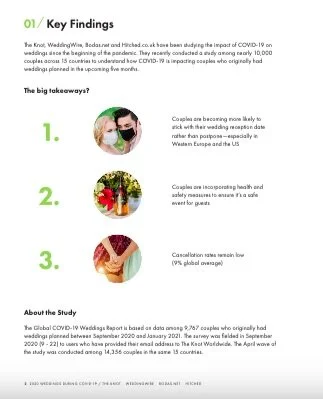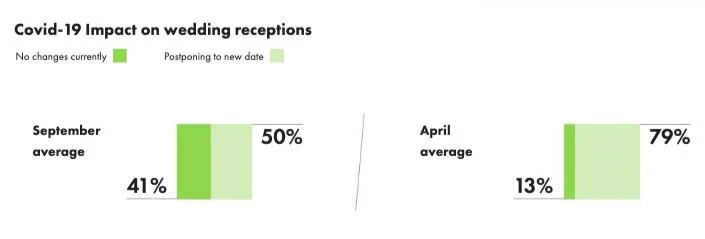In the past six months, I have had a lot of conversations with couples who are trying to plan a wedding during the COVID-19 pandemic. One of the most common questions they ask is, “What are other couples doing?”
The question doesn’t surprise me. Wedding planning is an odd mix of being both highly universal and desperately individual. A couple is simultaneously doing something that many other couples have done before but that they have never done before together. And that was before a global pandemic changed everything.
So when a couple asks me “What are other couples doing?” I tell them what I’ve seen working as a wedding planner during COVID-19. Now, I have some hard numbers to reference: the Global COVID-19 Weddings Report.
Before I launch into the report, a few notes:
Most of the survey is based on data from 9,767 couples who had weddings originally planned between September 2020 and January 2021. The survey itself was sent via email in September 2020. The send date feels important to me because, speaking personally, my feels around the state of the world (and the status of the pandemic) change by the day, let alone by the month.
The report also includes data from two other surveys. One is from a survey run in April 2020 (14,356 couples in the same 15 countries). The other is from a survey conducted in August and September 2020 (4,000 respondents with original weddings between March 2020 and August 2020). I noted where each survey was used in the story below.
“Global” is a bit of a misnomer since only 15 countries were surveyed. Granted, that’s 14 more countries than I personally have information for but still, worth noting. The surveyed countries were: the U.S., Canada, the United Kingdom, France, Italy, Spain, Portugal, India, Colombia, Brazil, Mexico, Argentina, Uruguay, Peru, and Chile.
The survey was run by The Knot, WeddingWire US, WeddingWire India, WeddingWire Canada, Bodas.net, and Hitched.co.uk. Remember: The Knot and WeddingWire merged in September 2018. Whatever your feels about this monolith (and I’ve shared mine before), it remains the only resource for large surveys of the wedding industry, which is wild since you’d think there’d be at least one independent survey out there for an industry that, at last count, made more than $72 billion a year.
OK, notes completed. Here are the highlights.
Five photos of people and only two pictures have heads — guess what color they are?
This isn’t a survey finding but it’s important: There are five photos of people in the five-page report. The two where the heads aren’t cut off are of a white, cis, skinny, straight, non-disabled couple. Think about it.
Courtesy of The Global COVID-19 Weddings Report
Courtesy of The Global COVID-19 Weddings Report
50 percent of surveyed couples rescheduled, 41 percent kept their original date (but did they?)
Weird thing about these numbers: When you first read them, it’s easy to think “Oh wow! Forty-one percent of people didn’t change their 2020 wedding plans at all?!”
This is what I thought until I read the report more closely. These numbers only refer to wedding receptions, not wedding ceremonies plus receptions (i.e. what we usually think of when we think of “a wedding”).
So what the survey actual says is that 50 percent of surveyed couples rescheduled their reception to a new date. It’s unclear what, if anything, the couple might have done on their original date in 2020.
The second stat (the 41 percent) refers to couples who did something nuptial on the day that was originally scheduled to be their wedding day and who have nothing nuptial going on in 2021. The confusing part is what the “something in 2020” was. It’s not clarified in the report. Based on my experience, it usually means a ceremony and a reception with fewer guests plus a combination of health and safety measures.
Language matters because while the report is correct in saying 41 percent of surveyed couples “kept their original date,” it’s unclear if that 41 percent also kept their original plans. That’s an important distinction because it means that a lot more people than 41 percent changed their wedding plans because of COVID.
More couples are “sticking to their original date” (which means what exactly?)
The third page of the report includes a series of bar graphs. The dark green bar indicates “no changes currently” and the light green bar indicates “postponing to new date.”
Two different sets of data are presented. One set is from the September survey (the 9,767 couples who had weddings originally planned between September 2020 and January 2021). The second set is from the April survey (14,356 couples whose specific wedding dates aren’t provided in the report).
Courtesy of The Global COVID-19 Weddings Report
The point of the bar graphs is to show how couples’ attitudes have changed around having a wedding during COVID in the five months between April 2020 and September 2020. The “no changes currently” bar is much higher for the couples surveyed in September than for the couples surveyed in April (41 percent v. 13 percent).
That would seem like good news until you ask what “no changes currently” means. Based on the report, “no changes currently” seems to mean the couple made no changes to their wedding at all. But the press release suggests that “no changes currently” just means the wedding date hasn’t changed but the wedding plans most certainly have.
These are two very different things.
9 percent of surveyed couples canceled (but canceled what part?)
“Canceled” is presented in the report as the least popular option. “Couples who originally had a wedding planned for the upcoming five months plan to keep the date of their wedding receptions or postpone to a new date rather than cancel all together.” (Emphasis added.)
The question here is what do we mean by “canceled”? Based on what I’m seeing as a wedding planner, that word can mean a lot of different things right now.
Did the couple cancel their original 2020 wedding, get married this year, and are also planning a larger event for 2021? I’ve had six couples do this.
Did the couple cancel their 2020 wedding, not get legally married, and are planning a larger event for 2021? I’ve had four couples do this.
Did the couple cancel their original 2020 wedding, get legally married, and have no plans for a 2021 event? I’ve had three couples do this.
Did the couple cancel everything including each other (i.e. “We broke up”)? A friend of a friend had this happen but that’s a different story.
I offer all of the various combinations above to illustrate that to “cancel” a wedding doesn’t necessarily mean the very biggest, baddest outcome (“You canceled your wedding and true love will elude you forever!!!”). Unfortunately, you wouldn’t know that from the language in the report. “Canceled” is presented as one option and a very bad one.
83 percent of couples are “incorporating safety measures and taking other precautions” (like…?)
I mean, good. There is a global pandemic. But also, who are these rogue 17 percent who aren’t incorporating any kind of safety measures? Wait. Actually. Don’t answer that. I’m not sure I want to know.
Something I do desperately want to know is what percent of couples took what specific safety measures. Unfortunately, the report lumps the various ways that we can protect people at weddings into one big pot.
Providing hand sanitizer is thrown right in with face masks which is tossed in alongside social distancing. Except, of course, there’s a big health and safety gap between plopping a communal vat of sanitizer onto the middle of a buffet table and requiring every single person at your wedding to wear a mask so their germs don’t kill somebody.
Courtesy of The Global COVID-19 Weddings Report
To be fair — and I swear I’m trying to be — there is more detail in the press release announcing this survey. The press release uses the smaller data set collected in August and September 2020 to break down which specific safety measures couples said they’re taking. This set included 4,000 responses from couples who had “original weddings between March 2020 and August 2020.”
Those numbers are interesting — the 4,000 surveyed couples said they’re providing hand sanitizer (89 percent), encouraging social distancing (78 percent), requiring staff to wear masks (70 percent), and offering face masks to guests (63 percent) — but they’re not enough.
Did surveyed couples get a chance to pick multiple options or could they only pick one safety option on the survey? I’m finding that couples are, quite rightly, deploying as many options as they can to keep their people safe. It’s not hand sanitizer OR social distancing. It’s hand sanitizer AND social distancing AND masks and literally anything else we can think of to reduce risk.
What percentage of couples required masks? What percentage required masks for their guests and their vendors (not just for the “staff” mentioned in the results)?
What percentage of these weddings happened exclusively outdoors?
What other health and safety precautions are couples taking? More specifically, tell me about the “unique and creative approach” mentioned in the press release of couples providing their guests with “color-coded bracelets indicating their comfort level with interacting at the event.” How did those conversations happen?
100 percent of this report is from a different era
Surveys are important. They help us conceptualize large, amorphous trends so we can better understand our reality.
That’s useful, particularly in a world that feels more unknowable than ever and, in this way, the Global COVID-19 Weddings Report does a good job. It provides us with a much-needed look into a multi-billion dollar industry that’s currently on life support.
But also? This survey is so disappointing. Time and again, the wording drives home what really matters on a wedding day: how much money a couple spends.
Take this sentence: “Couples are hoping that delaying will allow them to have the wedding they always envisioned and the majority do not plan to cut their budget (average: 80 percent) or hire fewer vendors (87 percent).”
The first part is great. We love dreams! We love making dreams come true! But the second part? “Don’t worry! The lovebirds are still going to hit that national average of $34K! We promise!”
This isn’t what couples need. It’s not even what vendors need. I’m as worried as the next small business owner about if my small business is going to survive the pandemic. There is a good chance it does not! But using a major survey — the wedding industry’s only such survey— to champion pre-pandemic planning isn’t just outdated, it’s dangerous.
It’s as if nothing’s changed. Except, of course, everything has. You just wouldn’t know it from this report.




